The alternate route’s sixth Block stands out as one of the most memorable stages in a game crammed with them, because of a neat throwaway gimmick. Sure, it basically boils down to a case of stunt programming, but damn if it didn’t impress back in 1990 — and it’s one of the reasons I became so fond of Sypha.
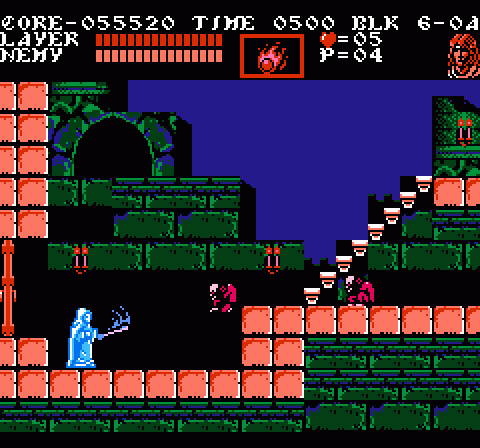
Between the quick tempo and pulsing back beat of its music, the sherbet-orange-on-dark-blue visual palette, and the way the stage spans a series of bridges, Block 06-A through 06D will likely remind you of Stages 07-09 and the theme “Wicked Child” in the original Castlevania. The boss at the end consists of two creatures that attack in twain, trying to surround you. Heck, the level’s opening even starts out by sending a couple of Flea Men after you — definitely a callback rather than a coincidence.
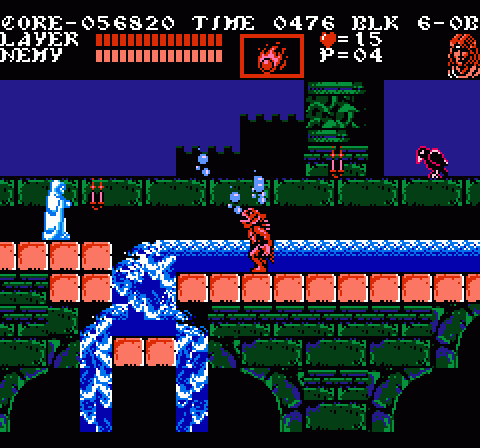
Strangely, Block 6-0A is a mere two screens long, sending you up a stairway and then down the other side with very little in the way of things to do. I guess the designers just needed to get a few more stairways out of their system before moving onto a horizontal orientation again.
The level proper begins at Block 6-0B, which is also fairly short so far as stage segments go; it’s only about four screens wide. However, the game packs a lot to see and do within that brief span. As denoted by the game progress map, Block 06 takes you from the outer tower to the inner castle across two bridges with a tower in the center. This is the outermost bridge, and it serves as a spillway for water cascading from above. (Where does this water come from? Who knows! The next-to-last stage features a similar spillway that could be responsible for this area’s waterfall, but that doesn’t work according to the map. So let’s just say a wizard did it.)
The water’s movement creates a current that pushes away from the waterfall at the center, meaning that you’re trudging upstream in the first half of the stage and being swept forward in the second. Both situations pose a different kind of threat, as hazards lurk both above and below the water’s surface and your uncertain footing makes it more difficult to react. Crows swoop down at you, adding the unpredictable arc of their attack patterns to the constant motion of the water. Meanwhile, Fish Men swim to attack, approaching as shadowy blobs in the water before springing up to spit fire at you — or not, as they’ll sometimes just swim into you and pop up once they’ve knocked you back.
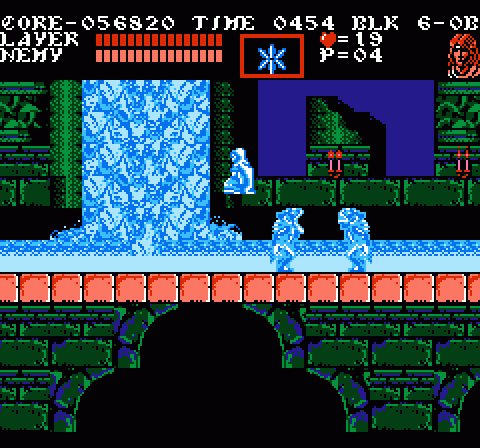
However, if you’ve brought along Sypha, you can grab the ice magic spellbook from a candle above the spillway and unleash hell here. Sypha’s magic doesn’t simply freeze bad guys — it freezes the water, too. All the way up the waterfall. It’s an impressive bit of NES technical chicanery that also doubles as a useful gameplay feature: When the water is frozen, you can walk on its surface and not have to worry about the current. And of course the enemies caught up in the freeze become immobilized as well.
Of course, the usual limitations of Sypha’s ice magic apply; each freeze only lasts for a few seconds. But it can come in pretty handy.
Once you fight your way along the spillway, either by surviving the currents or defeating them by brute force, you have to jump across a gap to dry land. In a particularly cruel twist, a Dragon Cannon guards the landing next to the door, perfectly positioned to send your protagonist of choice flying backward into the gap through which the water spills to lower ground. You can see responsible game design at work here again: Water flows into gaps on both sides of the spillway, but the first gap you encounter provides its own safety net in the form of a pair of lower blocks that prevent you from falling any further. So, if you’re swept back by the water flow or knocked back by an enemy when you first land in the stream, you’ll fall to safety. But if the Dragon Cannon gets you, well… it’s your own fault for sinking rather than swimming. So to speak.
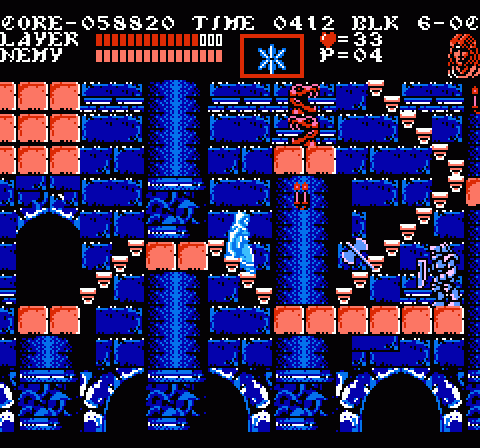
Block 6-0C presents you with the spillway’s central tower, which you navigate by traveling down below a central partition. Again, it’s a fairly compact space, but it consists of winding fragments of stairways that take you up and down, left and right. Enemies here take advantage of the uneven terrain and the Belmont crew’s limitations while climbing by focusing on projectiles. Besides bats (which are kind of like infinitely respawning projectiles in and of themselves), you face Dragon Cannons and Axe Knights. After the grueling stair gauntlet of Block 5-0A and 5-0C and the flashy gimmick of Block 6-0B, this area feels like good old-fashioned Castlevania content: Tough, but familiar. You’re vulnerable to projectiles while climbing and vulnerable to being knocked back into pits when on solid ground, but slow and steady wins this race.
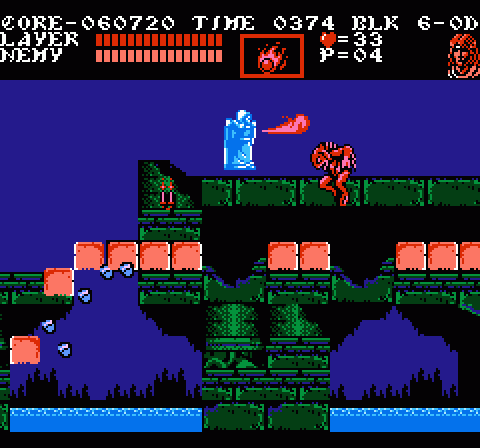
Block 6-0D should give you more of those Castlevania flashbacks, with its orange bridge through the night. The difference is that you’re not attacked by Medusa Heads here but rather Fish Men. Oh, and the bridge crumbles as you walk over it. My brain has subconsciously connected this sequence to the bridge before the Mummies in the original Castlevania because of the striking similarities between the levels, so I’m always pleasant surprised when I play the first game and don’t have to rush to avoid falling into a yawning chasm that opens behind me.
Stressful as the falling bridge may be, the level designers were kind enough not to force you to battle enemies as you dash forward. The Fish Men don’t start leaping up until after you’ve reached stable ground again — well, save one. A single Fish Man leaps into the air behind you as you’re reaching the very end of the collapsing bridge, totally harmless but signaling the advent of a new threat. Once you leap to the next blocks, they begin attacking in earnest; but by this point you’ve arrived safely at an area that doesn’t fall away as you walk along it. All of this happens in the span of a few seconds, so it can seem stressful and intense, but in truth that’s something of an illusion and this sequence is probably the easiest of the entire block. It’s a great example of stage design and enemy placement creating the impression of more danger than actually exists to raise the player’s pulse without being unfair or overwhelming.

In a neat (although perhaps not entirely intentional) inversion of that famous basement in Castlevania‘s very first level, you fight Fish Men and then go to a lower level, to the water’s surface. You’ve descended below ground level to fight Fish Men below before, but what lurks beneath the Fish Men?
Turns out it’s a pair of fire-breathing water serpents stolen from Kid Icarus. Hewdraw, is that you?
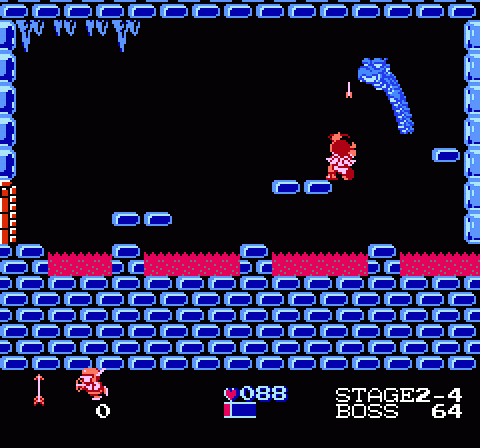
These guys are pretty nasty, since they can pop up in four different spots spaced across their lair, rising to different heights before blasting jets of flame that have the same range as Trevor’s whip or Sypha’s fire spell. Ranged abilities — particularly the Axe, the Boomerang, or lightning magic — work best here. It’s a difficult battle whose challenge lies in the need to respond to multiple unpredictable threats. Thankfully, I’ve never seen them try to pin me in by surrounding me on both sides, so there’s still an element of a fair fight at work.
Yeah, this area pretty much single-handedly justifies Sypha to me. The water, man!
Also, is this unfinished or are you just doing the rest of the block separately?
Oh, wait, nevermind. I didn’t register the sea serpents as the bosses for some reason.
The ice freezing is very cool, they could have made it a simple local effect with a few sprites as blocks, but instead they made it global. The entire map must have been designed with optional floors that could be turned on and off.
I reckon Castlevania 3 was the most technically advanced NES game ever made. The Clock Tower rotations still amaze me. Getting the math and sprite swaps correct for the pendulum was skilful. But I still do not know how they got those rotating gears to look as good as they did (for the NES, at least).
It is such a beautiful game of its time. I would love to read an interview with the programmers.
Thanks for this series, I am enjoying it.
Also, time for GrantTalk(tm)! There’s actually not a whole lot Grant does differently from Sypha here, though he can go under the bridge for a less-flashy-but-still cool alternative to freezing the water.
Holy crap…Sypha can freeze water? Interest sparked! I should really take advantage of this game having a password system and see if it also applies to the stages you normally wouldn’t be able to use her until the hard mode replay.
Been testing Sypha out a bit. I guess she needs running water to be able to freeze it; didn’t work at the swamp and she sinks as soon as she touches the water pits in the mad forest.
However, that doesn’t really matter, because ice is so busted against standard foes. I was freezing and smashing Simon wraiths, dragon cannons, and those asshole owls, toads, and mudmen. I even killed a normally unkillable blood skeleton! Freeze, bat, boom! Freeze, bat, boom! Freeze, bat, boom!
Fascinating! As I read these delightful designs, I’m amazed not only by the fact that I survived this game (even the original version) but at the utility of Sypha! When I found her on my playthrough, I wasn’t struck by her and stuck with Alucard through the rest, I think, but to think that even the water freezes! Inspired to play through again, and with an eye towards the intelligent architecture you’ve so artfully pointed out, too.
I’ve always loved this game and thought it was great, but this series of articles is making me appreciate just how impressive it really is. SCIV is probably my favorite of the series, but now I see how many of the awesome set pieces and technological tricks that game employs were actually done first in CVIII, which makes it even more mind blowing that they were able to do these things on the NES. SCIV actually seems like a tiny step backwards in this context. There have been some really great games in the series, but none of the “standard” side-scrolling CVs have ever quite gotten back to the level of complexity, intricate planning, and challenge demonstrated by CVIII.
I love all of these Anatomy articles (and GlassKnuckle’s as well) and the layout of the Castlevania book you posted earlier looked fantastic. Definitely going to purchase it once it comes out.
The freezing of the lake is a very, very cool character specific power. I may be mistaken, but can’t Syphia also jump on frozen enemies and use them as stepping stones? Given how quickly enemies become unfrozen, this seems like a risky move and I’m not sure if there’s anywhere in the game where this would be particular handy, but still a nice touch.
Yeah, she can Metroid ’em.
All this talk of Sypha makes me want to solo the game using her. I did a solo Trevor and Alucard. I don’t even want to _think_ about a Grant solo, what with his tiny stabbing utensil.
In the Japanese version it’s possible!
(i promise this is the last time i’ll mention the japanese version and/or grant until you address either directly in the blog)
I actually did use Grant when I went through the Japanese version. It’s also quite a bit easier, not just because of Grant’s newfound (oldfound?) prowess, but some tweaks to various enemies, like the Bone Pillars. Dracula himself is a good deal easier, as well. He does less damage, the lasers are easier to dodge, and so on.